February 19, 2008
This morning I decided to skip the breakfast buffet and just grab one of the Poptarts I had packed for the trip. Before checking out, we walked around the hacienda and just took in all the scenery. We picked limes from the lime trees, birdwatched a bit, and just breathed in the fresh mountain air. But by 8:00am we were back on the bus and ready to go to our second reserve, Sierra Chincua.
About two hours from the hotel, on a mountaintop not far from El Rosario, Sierra Chincua is a wilder colony. The ejido who own the land have only recently begun to develop the area into an eco-tourism attraction. The road to Chincua was bumpy and wound its way up the mountain like a snake. When we pulled into the parking lot we could immediately see the differences between El Rosario and Chincua. To begin with, there was no parking lot at Chincua- it was just a grassy area. The shops and restaurants were much smaller and there were a lot fewer of them. It was a sharp contrast from the day before.
Once we unloaded from the bus, we were able to rent a horse for the ride up the mountain. The ejidos at the bottom of the mountain told us that the Monarchs were only over the first hill and only a 5 to 10 minute ride by horse. After checking our altitude (10,700 ft) we mounted our horses and were led up the mountain. The horse ride was enjoyable and relaxing. My legs and lungs were very happy to get the break the horse offered- no walking and hiking! The ride was quite short- after about ten minutes, the horses had gone as far as they were allowed. We dismounted and prepared for the short walk to the colony. Due to the warm weather, the monarchs had moved further down the mountain and were very close!
When we arrived at the top of the Mountain we were greeted by Francisco who is the head Ejido and who is in charge of 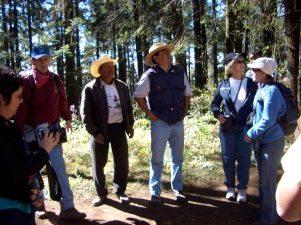 all the money for the Sanctuary of Sierra Chincua. Francisco is very passionate obout preserving the Oyamel Fir forests for the Monarchs, and has spent the greater part of his life battling illegal loggers and working towards re-foresting the tracts of forest that were illegally cut down. Francisco received a big boost a couple of weeks ago when the President of Mexico, Felipe Calderon visited Sierra Chincua and rode horses with Francisco into the Sanctuaries to see the Monarchs. Francisco said that President Calderon has pledged to help stop the illegal logging by giving the Mexican Army more of a presence in the Sanctuaries with the responsibilities of protecting the forests for the butterflies. He also explained that the colony has allowed his town, down the mountain, to begin local improvements. They were recently able to purchase a new bell for the church for $9000 pesos and begin renovations on the church. They will soon begin to build a high school in their town. Francisco was extremely passionate and his attitude was contagious. Many of the teachers became teary-eyed during his speech and we gave him a round of applause when he finished. He was just as grateful to meet us- he was grateful to us because he said it was our work with the students in the US and Canada that convinced the President to visit the colonies. The popularity of the monarchs in the US/Canada has shown the Mexican government that other countries do care, too.
all the money for the Sanctuary of Sierra Chincua. Francisco is very passionate obout preserving the Oyamel Fir forests for the Monarchs, and has spent the greater part of his life battling illegal loggers and working towards re-foresting the tracts of forest that were illegally cut down. Francisco received a big boost a couple of weeks ago when the President of Mexico, Felipe Calderon visited Sierra Chincua and rode horses with Francisco into the Sanctuaries to see the Monarchs. Francisco said that President Calderon has pledged to help stop the illegal logging by giving the Mexican Army more of a presence in the Sanctuaries with the responsibilities of protecting the forests for the butterflies. He also explained that the colony has allowed his town, down the mountain, to begin local improvements. They were recently able to purchase a new bell for the church for $9000 pesos and begin renovations on the church. They will soon begin to build a high school in their town. Francisco was extremely passionate and his attitude was contagious. Many of the teachers became teary-eyed during his speech and we gave him a round of applause when he finished. He was just as grateful to meet us- he was grateful to us because he said it was our work with the students in the US and Canada that convinced the President to visit the colonies. The popularity of the monarchs in the US/Canada has shown the Mexican government that other countries do care, too.
As we climbed the small hill, the path forked ahead of us. To the right, the downhill path was dark and cool. We could see the oyamel covered in monarchs, like fur on the trees. Many of the butterflies were lifting into the air as the warmth from the sun hit the branches higher up the mountain.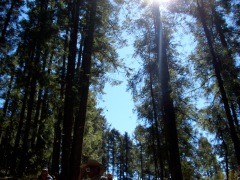
To the left, you climbed up into the peak of the mountain, where the sun shone like golden fire. The light blue sky was alive with orange and black, fluttering, flapping, diving, and streaming down the mountain. The river of monarchs, mariposas, flowed around us. There were no ropes separating us form the monarchs. It was and absolute avalanche of orange and black.
For a while I just sat on the mountain and absorbed the scenery. Soaking in the wonder of the colony. It was as close to being one with nature as I can ever imagine being. You could hear the breeze blowing through the trees and the quiet flapping of 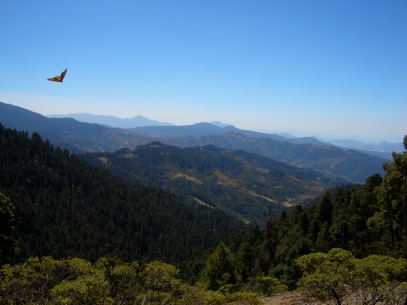 millions of butterfly’s wings. A monarch even landed on my head!
millions of butterfly’s wings. A monarch even landed on my head!
The ride back down the mountain was also on horseback. It was even better going down the mountain- the steep, gravel-filled path looked treacherous to this blogger! After we dismounted from our horses, we perused the shops. We decided to eat our brown-bag lunches in a corner of the reserve, out of the way of the busy shops and restaurants. We were soon joined by two small children, ages three and seven. They laughed and signaled to us as we struggled to communicate, despite our language barrier. They giggled and showed off, playing catch with each other.
We spent about three hours at the colony and then drove an hour west to visit Alternare. On the way, we passed through a large crowd of men, women, and children carrying fireworks, singing, and dancing. At the back of the crowd we saw a small coffin with glass sides. We were shocked and horrified at what we assumed was a ghastly funeral ritual. However, Marcos explained that it was a very important tradition in Catholic villages. The coffin contained a baby Jesus and represented his death for their sins. The coffin was carried from town to town on a daily basis, and it was a very big honor to host the coffin in your church. The crowd would set off the fireworks before reaching the next town, so that the townspeople were prepared to receive the baby Jesus. It was fascinating!
About 45 minutes later, we reached Alternare. Alternare is a Mexican non-profit organization that works with the natives in the monarch sanctuary areas to promote sustainable living- food production, forest conservation, and environmentally sound economic activities. We visited their training center just outside of Angangueo, where they educate instructors. These instructors then go back to their homes, carrying the knowledge from Alternare with them. They then work as leaders in their community, sharing the knowledge and spreading the ideas. We were introduced to a young boy, no more than seventeen years old, who had spent the last year training at the facility. At the end of February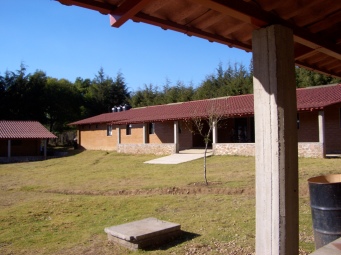 he would be going back to his home to begin sharing his knowledge with his community. The young man spent about 30 minutes explaining Alternare and their work to us. He looked so nervous! You could tell this was some type of final exam for him, and he looked terrified. But he did a wonderful job!
he would be going back to his home to begin sharing his knowledge with his community. The young man spent about 30 minutes explaining Alternare and their work to us. He looked so nervous! You could tell this was some type of final exam for him, and he looked terrified. But he did a wonderful job!
Much of what they teach at Alternare is knowledge that the local people knew many generations ago, but has long since been forgotten. For example, they teach crop rotation, adobe as alternative building technique (instead of oyamel wood), construction of wood-saving stoves, tree nurseries, reforestation and sustainable use and management of the forest, use and preparation of medicinal plants , and honey production. After the wonderful presentation, we passed a collection hat around and made a wonderful donation to Alternare. A few teachers (who had been on the trip before) delivered donations from their schools and students. The men and women at Alternare then offered their goods to us, and many teachers bought honey and herbal medicines. It was wonderful!
Filed under: monarch butterflies, monarchs, professional development | Tagged: monarchs, MTN Mexico trip, trip journal |





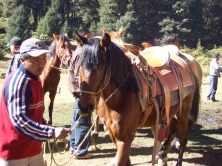
[…] Monarch Teacher Network: Day 4 in Mexico […]